I ended part one of the Pittstown Inn when the Revolution came to an end. The Treaty of Paris was finally signed on September 3, 1783, thanks to the efforts of America’s representative at the negotiations, Benjamin Franklin.
The next stage in the history of the Pittstown tavern should cover the years from 1783 to 1800, when the tavern’s owner, Moore Furman, began thinking about replacing the old tavern house with a new one.
The question becomes—what was going on with the tavern between those years? Much to my dismay, I can say next to nothing about what was going on with the tavern. Clearly, there were tavernkeepers at work there while the owner, Furman, had returned to his home in Trenton.
Innkeepers renting from Furman
The State Archives do have tavern licenses for the year 1781, including the tavernkeepers in Alexandria Township, which was the location of Furman’s tavern. They were William Davison, Charles Fleming, Benjamin Jones, George Newton and James Powers. As might be expected, there is very little information available about these gentlemen, and none of their petitions for licenses say anything about the location of their taverns, other than the township of Alexandria. None of them mention the village name, either as Hoff Town or as Pitts Town, so there is no way to tell who if any of them ran the Pittstown Inn.
Charles Fleming is the most interesting. He was born about 1759, the youngest child of Samuel Fleming & Esther Mounier, and thus the younger brother of Mary Fleming, wife of George Alexander, about whom I’ll have more to say. But I know nothing else about Charles.
According to Ms. Brecknell (see part one), Pittstown was considered part of Kingwood Township during this time. I do wonder about that, but to be on the safe side, I also checked the 1781 petitions for Kingwood. There were only three, one of them being Gabriel Hoff, whose tavern was in Baptistown. The other two were Joseph Hart and Peter Howell, whose tavern locations were not mentioned.
Guild & Furman
According to Henry Race and Ursula Brecknell, Furman left management of his tavern and other properties to his son John W. Furman and his store manager Benjamin Guild.1
John White Furman was the second child of Moore Furman and Sarah White. He was born in Pittstown on March 6, 1777 and would have been of an age to run the Furman tavern in the late 1790s. Benjamin Guild (1764-1815) was the youngest child of Rev. John Guild and Charity Hunt of Hopewell Twp. Being 13 years older than John W. Furman, Guild would probably have taken him under his wing. He had taken over management of the Furman store in Pittstown sometime in the 1780s.
In addition to Furman’s store, Guild ran a grain distillery and a nail factory. He employed one William Probasco as his miller, who, according to local historian Isaiah N. Leigh, “lived in a house that stood back of the tavern, in what is now the apple orchard of Mr. Stryker.” Leigh wrote this in 1886, when “Mr. Stryker,” i.e., Larason Stryker, was the Pittstown innkeeper. Leigh also noted that “Mr. Guild was elected a Trustee of the Bethlehem Presbyterian Church on 1 Mar. 1804, which office he held until 1807.”2
As for John W. Furman, he may very well have been running the tavern during the years I am concerned with, but soon afterwards, on April 8, 1802, he died at the age of 25, unmarried. This must have been a family tragedy.
New County Seat
In a way, one might say that the Furmans were not really a Hunterdon family, but only if you count Hunterdon as it is today. Back when Furman was around wherever he lived—Hopewell, Trenton, Maidenhead or Pittstown—he was in Hunterdon County. Not until 1838 was Mercer County created out of the lower part of Hunterdon. The new county included all those locations where Furman lived, but by then he was long gone.
The first big event for Hunterdon County during this time period (1783-1800) happened in 1785 when the county freeholders decided they needed their county seat in a more central location. Ever since the county’s founding in 1714, Trenton had served as the county seat. Back then it was the only municipality capable of hosting meetings of any size.3 But much had changed since then, and, according to Kathleen Schreiner, most of the county’s population had located in Amwell Township (today’s East & West Amwell, Lambertville, Delaware, Raritan and Flemington).4 Too often freeholders from the northern townships of the late-18th century (Alexandria, Bethlehem, Lebanon & Tewksbury) were not showing up at meetings because of the difficulty of traveling to Trenton and back. Meetings began to be held in alternative locations, like the taverns in Pennington, Ringoes and Flemington.
George Alexander
The Flemington meetings undoubtedly took place at the tavern of George Alexander (c.1745-1800), son-in-law of Samuel Fleming, and brother-in-law of Charles Fleming. Back in 1779, Alexander had purchased at a sheriff’s sale a 6.5-acre lot, originally part of Samuel Fleming’s property, on which Alexander established his tavern.
Ms. Schreiner noted that Freeholders were meeting informally at Alexander’s tavern until March 15, 1791, when Alexander sold a half-acre from this lot to the Freeholders of Hunterdon County, providing them with the real estate needed for construction of a new county courthouse and a county jail, one to replace the deteriorating one in Trenton. The deed was recorded in Book One of the Hunterdon County deeds5 and is a very important one for the history it provides.
Here a detail from the deed, and a transcription of some relevant parts (with original spelling):
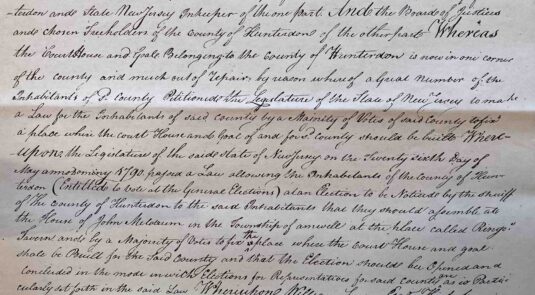
Whereas the Court House and Goale of the county is much out of repair by reason whereof a great number of the Inhabitants of sd County petitioned the Legislature of NJ to make a Law for the Inhabitants of sd county by a Majority of Votes of sd County to fix a place where the court House and Goal of and for sd county should be built;
Whereupon the Legislature of sd state of NJ on 26 May 1790 passed a Law allowing the Inhabitants of the County of Hunterdon (Entitled to vote at the General Elections) at an Election to be Noticed by the sheriff of the county to the sd Inhabitants that they should assemble at the house of John Meldrum in Amwell at the place called Ringo’s Tavern and by a majority of votes to fix the place where the court House and goal shall be built for the sd county . . .
Sheriff William Lowry gave the notice required by law that the 2d Tuesday in October next (1790) the election would be opened—it took several days. A majority voted for the Court House & Goal to be built in Flemington.
So, by permission of the state legislature the citizens of Hunterdon County decided where their county seat would be located. Actually, the question they decided was where to build the courthouse, but that is the same thing. Returning to the deed:
A lot of one-half acre, being part of a lot whereon the said George Alexander lives and on the southeast thereof and on the road leading to Trenton [Route 31] and also butting on the road as now used leading round the said lott to Howells Ferry on Delaware River [Mine Street & Route 523] and the other two sides butting & bounded on other parts of the sd George Alexanders lott . . .
This sale from Alexander to the Freeholders took place the following spring, on March 15, 1791. Construction of the courthouse took place shortly afterwards. (Note: The Courthouse of 1791 was replaced in 1828 by the courthouse that is still standing today.)
There is much more to say about the earliest years of Flemington as Hunterdon County seat, but I must return to Pittstown.
Furman’s Tavern
Recall from part one that the lot on which the Pittstown tavern was located belonged to Isaac FitzRandolph, and after his death in 1768, it remained in possession of his widow, Catherine Hoff, daughter of Charles Hoff.
Sometime during the Revolution, the Widow FitzRandolph died. Like her husband, she was rather young when she died, only in her mid 30s.6 Her property, i.e., the 2-acre tavern lot, was acquired by Moore Furman. Sadly, just like his deeds from Catherine FitzRandolph’s father, Charles Hoff, the tavern deed was never recorded. Perhaps this was a consequence of the turmoil created by the Revolution. It certainly is hard to understand why the owner of so many properties would neglect such a legally important act for establishing possession.
Peter VanKirk
The first verifiable post-Revolutionary War tavernkeeper at Pittstown was Peter Vankirk. He is another one of those early Hunterdon residents who is difficult to research, beginning with his unknown parents. He is thought to have been born Peter VanBuskirk in Hopewell Township on Jan. 8, 1759.7
I cannot say I am certain that this Peter VanBuskirk, otherwise known as Peter Vankirk, was the same as the Peter who managed the Pittstown tavern, as there were other Peter Vankirks in the area at the same time.
For instance, there was a Peter VanBuskirk the elder (1702-1778) who owned real estate in Bethlehem & Lebanon Townships. He wrote his will on February 6, 1775, leaving to his youngest son “Peter V. Buskirk” his homestead farm of 120 acres bordering Spruce Run Road. Peter the elder died in July 1778 in Lebanon Township; his will was recorded on July 30th of that year.
This Peter Jr. was the son of Peter the elder’s second wife Jane, about whom I know nothing. But this explains why Peter the elder was 57 years old when his youngest child was born.
The earliest mention I have found of the Pittstown tavern keeper so far is his marriage on October 15, 1780 to Esther Drake (1764-1847), daughter of Thomas Drake and Dorothy VanKirk of Hopewell Township.8 The next I know of Vankirk was in 1792 when he enrolled in the Hunterdon Co. Militia. By then he was 33 years old.
It is possible that Vankirk was keeping Furman’s tavern in the 1790s. There are few tavern licenses on file for that time period. In fact, the first tavern license petition I have for Vankirk was in 1801 for a tavern in Alexandria Township.9 There is good reason to think that the license was for Furman’s tavern based on a most amazing letter that was written by Furman that year.
A New Tavern, 1801
Thankfully, unlike Furman’s deeds, this letter was saved. Hunterdon historian Isaiah N. Leigh made a presentation about it to the County Historical Society which got printed in the Hunterdon Republican on January 26, 1887.10
Mr. Leigh’s focus was on Benjamin Guild, who ran the Pittstown store during the later years of the 18th century. As part of his presentation, he included the whole of Moore Furman’s letter to an unnamed recipient. For an historian of the Pittstown Tavern, one could not ask for more. Here is the letter as reproduced in the Hunterdon Republican, with a few comments from me:
“Dear Sir: –John W. Furman is gone to see Pitts Town and all its inhabitants.
I mentioned to you in my letter by John, that M. Van Kirk had been with me about a new tavern house, for we both agree that it would be throwing money away to repair the house now there, and further, that the one now there will not do at all much longer.
Interesting that he referred to his son as John W. Furman. “M. Van Kirk” was most likely the Peter Vankirk who was licensed to operate a tavern in Pittstown from 1801 through 1806. 1801 is the earliest year I have in which the name ‘Pitts Town’ was used, although undoubtedly Furman used it much earlier.
Furman continues:
How is a new house to be built? That is the question. Supposing that it is attempted, what is the size? To build upon too small a plan for the stand will be doing the business by halves. I would therefore lay a foundation large enough to accommodate custom. If the whole house could stand the winter after the new one is begun, if necessary.
I should note that it was common in tavern license petitions to refer to a tavern as a “tavern stand,” or simply a stand, which seems to suggest that in the very earliest years, men selling alcohol did so from wagons that moved from place to place.
What makes this letter exceptional is that it shows how much care Furman took over his properties. From what we know of him, it appears that he always thought big, and his plans for the new tavern show that was still the case in 1800. Furman’s plans are so specific, it makes one wonder if he and his builder dispensed with an architect.
The size of a house I have an idea for that stand is about 30 by 40, the first story of stone, on a level with the road, running back into the hill, on the top of which set a frame of two-story, this may be thought too large for the present day, but in all the buildings I make I look forward until to-morrow. I wish you to make an estimate as near as you can of the cost of such a house, built strong and plain, and then if I double it I may be near the mark. I confess I should be very proud of a good house of entertainment there, which, if well kept, would be a very good stand in a few years, in my opinion. I will make a plan of a house of that size; divided as I think may be best accommodated for a tavern. Will it not be cheaper to build all with stone up to the Square, then wood or brick, and enclose the gable ends with wood?”
As things ended up, the entire exterior was built of stone, which turned out to be a blessing. The stone walls survived a conflagration in 1913 that destroyed the interior. Hats off also to the person who saw that the building could be restored to its original glory. Here is a photo, displayed on today’s tavern walls, of the tavern after that devastating fire:
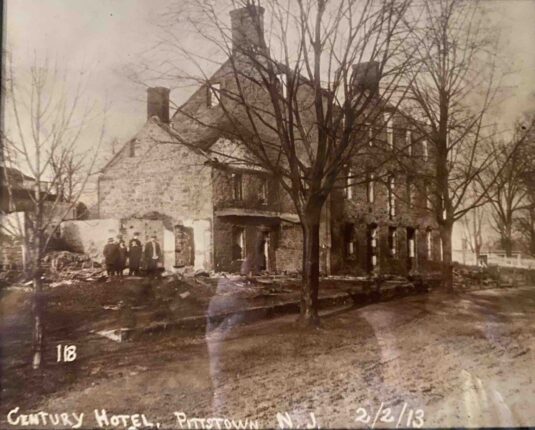
The next sentence is unbearably tantalizing:
You have on the other half sheet a rough draft of a Tavern House at Pitts Town.
Which means there was a floor plan included with this letter. Apparently, the floor plan did not get saved. (I sure hope someone proves me wrong about that.)
Those interested in the history of the evolution of taverns into hotels will find this next paragraph fascinating.
In the first place I have supposed that if a good house is built there and well-kept a few years, that it will be well accustomed; and in the second place I have had respect to the situation of the ground where it is to stand – the first story level with the road is to accommodate the common people that travel, such as carters, &c. The second story is for more respectable travellers, and public meetings, and for that purpose the end of the house next the kitchen may be left for one room, and will be about 16 by 38, sufficient to dine upwards of 40 people – and the other end may have a swinging partition so as to be thrown into one room when necessary, then there could be 70 or 80 people accommodated at once, – the 3d story must be cut up into Bed rooms for traveling commoners.
If I build, it shall not be a Henroost. The question then is can I build a respectable house. You will therefore tell me how it may be done with the least expense, and then I will soon determine yea or nay. You will tell me too who will undertake to have it done, for if I had a bushel of Eagles I cannot do it myself.
Yrs affly, M. Furman.”
What Furman ended up with was certainly no “henroost,” and must have been constructed by a very able builder. Here is the oldest available photograph of the tavern, with the name given it by Furman: “Century Inn.” (Turning the corner from the 18th to the 19th century must have been quite a significant event for those around at the time.)
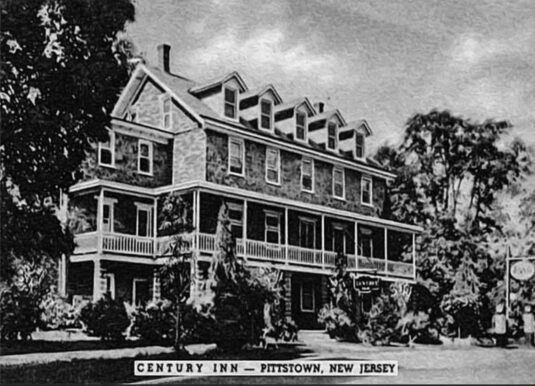
Here is what Ms. Brecknell had to say about the new tavern:
This is the tavern building (Pittstown Inn) at the crossroads, at the same site as Hoff’s Tavern. The swinging partition may have been a popular feature for inns of the time. At least one other tavern had such an arrangement, on Foot Hill Road in Bridgewater Township, Somerset County, now on the National Register. This feature of the Pittstown tavern no longer exists, assuming it was actually constructed, because the interior of the building was consumed by fire in 1913. The walls of the 1801 building have survived, but the interior was destroyed.
I wish I knew how Ms. Brecknell knew that the new building was constructed on the site of Hoff’s tavern. She apparently had access to Furman’s letters, and the information might have been found there. It would probably have simplified things to keep the tavern in the original location.
The First License
The first tavern license granted at the time that the new “tavern stand” was built was dated 1801, but there is no way to know if that was before, during, or after the tavern was reconstructed.
As mentioned above, it was granted to Peter Vankirk. Note that it mentions that VanKirk managed the tavern the previous year. The fee was only $10, which surprised me, given the grandeur of Mr. Furman’s new building. (Flemington & Ringoes licenses cost $16.) Given that the new tavern was built on the location of the old one, it would seem there was a large part of the year in which there was no functioning tavern there.
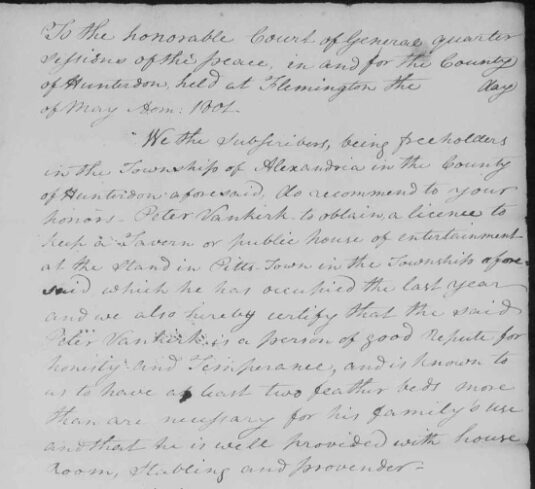
Tavern licenses were actually petitions, which had to be signed by a dozen or more citizens. The petitions were often signed by the important men in the neighborhood, although VanKirk’s petition was not signed by Moore Furman, who was probably in Trenton at the time. Here are the men who signed the 1801 Pittstown petition (list rearranged alphabetically): Henry Apgar, Samuel Arnwine, William Boss, Henry Case, John Duckworth, David Everitt, Jno C. [E?] Forman, Ralph Guild, Nicholas Pickel, Jno Rockhill, Jacob Stoll, and Elias Tunison.
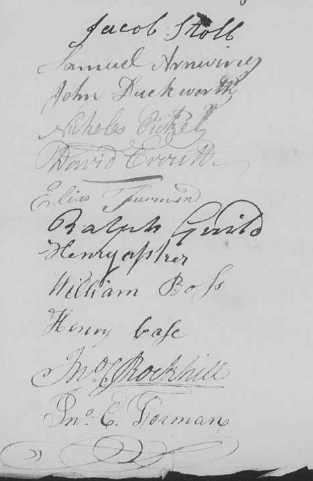
Many of the men who signed VanKirk’s petition were themselves tavernkeepers: Henry Apgar, Samuel Arnwine, William Boss, and David Everitt. I was surprised to see how often this happened. Innkeepers and tavernkeepers of that time seemed to have little sense of competition between them. Peter Vankirk signed Arnwine’s license petition.
The Court of Common Pleas minutes for the May term of 1794 lists a license granted to Henry Apgar in Alexandria Township. Samuel Arnwine’s tavern was also in Alexandria, and like Apgar, his petitions did not say anything else about his tavern’s location, perhaps at Everittstown. It was not the Hickory Tavern, which was run by Peter Vansyckle at this time.11
William Boss signed Samuel Arnwine’s 1801 petition as well as Vankirk’s. He did not have a tavern until several years later. As for David Everitt, David Sr. signed several petitions for tavernkeepers in Alexandria Twp. over the years, but it was probably his son David Jr. who operated a tavern in Amwell Township.
The Vankirk licenses for 1802-1804 were all granted to ‘Vankirk of Pittstown’ and petitioners on his behalf were all “Inhabitants of the Township of Alexandria.” They were:
Wm Abbott, Jno B. Allen, Samuel Arnwine (2), William Boss, John Case, John Chamberlin, Jesse Delrumpel, Thomas Derumple, John Eckel, David Everitt, Jno. E. Forman, Elias Furman (2), Benj’m Guild, Ralph Guild (2), Isaac Hartpence, James Hartpence, John Huff, Holloway W. Hunt, Paul Kels, James Larason, Abraham Larew, Peter Lennard, Robert Little, Jeremiah Matthes? James Mettler, John Mettler, Nicholas Pickel, Wm E. Potts, Jno. C. Rockhill (2), Jacob Stoll, John Taylor (2).
As indicated, some of the petitioners signed twice, in different years. In 1804, in addition to the list of supporters, there were two “sureties:” N. [Nathan] Price and Benj. Blackwell. This was not always the practice.
It may have taken 3 or 4 years to finish the building. It was not until 1805 that the license fee was raised to $14, suggesting that the new building was finished, furnished and accepting business. The next year the fee was reduced to $12, which was still $2 more than the usual fee for Hunterdon taverns. It remained at $12 until 1815.
1801 was a big year for the VanKirk family. In January Peter and Esther’s daughter Sophia (1782-1866) married Thomas Hartpence (1779-1860) of Kingwood Township, son of John Eber Hartpence and Hannah Kitchen. The couple had 11 children from 1801 to about 1824. In July 1805, Peter & Esther’s other daughter, Mary (1787-1868), married Benjamin Taylor (1781-1853), the son of John Taylor Sr. and Sarah Abbott of Alexandria Township. This couple moved to Martins Creek, Northampton County, PA.
In 1804, Peter VanKirk acquired a large tract of land from Ralph Guild, the brother of Moore Furman’s store manager Benjamin Guild. Capt. Ralph Guild was married to Sarah Emley, granddaughter of early Hunterdon landowner, John Emley, Esq.
The property was 101.34 acres in Alexandria Township,12 and bordered land of Moore Furman among others, as well as “the road leading from the town [Pittstown] to Everits town” and the original line of Lot No.114 of the Society’s Tract.
As mentioned above, the last year that Vankirk obtained a tavern license in Pittstown was 1806. The next I know of him he and Esther had moved to Hopewell Township. They were identified as Hopewell residents in a deed made in April 1808. Eventually the couple moved on to Tompkins County, NY, where VanKirk died intestate on March 10, 1824, age 65. Wife Esther lived to the age of 83, dying on April 10, 1847, in Northampton County, PA.
Isaac Bennet, innkeeper
The next tavernkeeper after Peter VanKirk was Isaac Bennet, who petitioned for a license in the Village of Pittstown on April 25, 1807. He was charged a fee of $12 that year and also in 1808 and 1809.
My research into Mr. Bennet is a little sparse. According to Find-a-Grave and Ancestry.com, he was born on Nov. 6, 1777, but his parents are unknown, as is the place of his birth. He married one Catrin Tinsman of Sussex Co. on March 5, 1797. It appears that he was also married to a woman named Phebe, born 1781, who died on June 19, 1826, and was buried in the Durham Cemetery in Bucks Co., PA.
Isaac himself died on August 9, 1840 and was buried next to Phebe. I cannot say when Catrin died, but there is a hint in the deeds suggesting that Catrin was indeed married to the Isaac Bennet who lived in Alexandria Township.
Isaac died intestate on August 9, 1840, in Hunterdon County. Administration of his estate was granted on Sept. 12, 1840, to his son Abraham Bennet and his son-in-law John H. Case. I know this because both men were named, together with Bennet’s other children and children-in-law in a deed in which they sold the only property that Isaac owned, being a lot of 24.75 acres in Alexandria Twp. They sold it to Christopher Tinsman of Alexandria Township for only $460. This was $1040 less than what Isaac paid for it in 1837, suggesting that Christopher Tinsman was a relative, most likely related to Catrin Tinsman Bennet.13
The Death of Moore Furman
Despite the many irons in the fire that Moore Furman was managing, he never let go of his Pittstown properties. It was during Isaac Bennet’s tenure that Furman died, on March 16, 1808, age 79. He had been a widower since the death of Sarah White Furman in 1796. The couple were buried in the cemetery of the First Presbyterian Church in Trenton. Furman had written a will on October 10, 1806, in which he left “to son-in-law Peter Hunt and my daughter Anna Maria Hunt, his wife, all that estate called Pitts Town, in Hunterdon Co., as surveyed by David Frazer, July 6, 1795 (700 acres), with houses and buildings, etc.” Quite a remarkable bequest—“all that estate called Pitts Town.”
And here I must pause before continuing the saga of the Pittstown Inn.
Footnotes:
- Henry Race, M.D., “Genealogical Sketch of The Furman Family.” This was published in “The Clinton Democrat,” but the date was not jotted down on the copy I found in the Furman Family notebook at the Hunterdon Co. Historical Society. Ms. Brecknell was cited in part one of The Pittstown Tavern. ↩
- Hunterdon Republican, March 17, 1886, and Jan. 26, 1887, Special History Edition, “A Few Historical Facts Relating to Hunterdon County Gleaned from Some Old Letters,” by Isaiah N. Leigh of Ringoes, formerly of Flemington. ↩
- I have written some articles about the earliest years of Hunterdon County’s existence. See “Creation of a New County, part three.” ↩
- See Hunterdon Historical Newsletter, Winter 1978, p.3, “Our Courthouse” for an excellent article on construction of the courthouse. ↩
- H.C. Deed Book 1 p. 584. Thanks to Sue Bennet at the Hall of Records for digging up the original clerk’s copy. ↩
- A contributor on Ancestry.com gave her death date as August 18, 1779 but failed to provide a source for that information. She left three minor children. ↩
- According to an Ancestry.com family tree that does not provide a source. I do not have the source for that date. It may have come from his death record. ↩
- Marrying a woman whose mother’s maiden name matches one’s own raises concerns among genealogists. Esther’s grandfather was Henry VanKirk (c.1700-1776), and grandmother was Dorothy Morgan (c.1703-c.1748), parents of ten children, none of whom were related, as far as I can tell, to Peter VanKirk. ↩
- Tavern license petitions can be seen on Family Search (familysearch.org/search.com). Select U.S./NJ, Hunterdon/Business Records/Tavern License Applications, 1799-1868. ↩
- Hunterdon Republican / Special History Edition – Hunterdon County Historical Society Presentations / A Few Historical Facts Relating to Hunterdon County Gleaned From Some Old Letters. / By Isaiah N. Leigh of Ringoes, formerly of Flemington. ↩
- A purchase by Arnwine from Apgar in 1800 was for a tract of 91 acres that bordered “a line near the house where the said Arnwine now lives” and “the grate road leading to Baptist Town.” This would put Arnwine somewhere between Baptistown and the Hickory Tavern. ↩
- H.C. Deed Book 10 pg.77. ↩
- H.C. Deeds Book 67 p.503 and Book 84 p.222. ↩